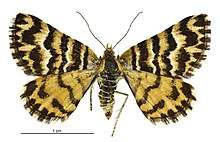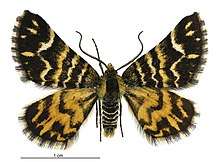Notoreas simplex
Notoreas simplex is a species of moth in the family Geometridae. It is endemic to New Zealand.
| Notoreas simplex | |
|---|---|
 | |
| Female | |
 | |
| Male | |
| Scientific classification | |
| Kingdom: | Animalia |
| Phylum: | Arthropoda |
| Class: | Insecta |
| Order: | Lepidoptera |
| Family: | Geometridae |
| Genus: | Notoreas |
| Species: | N. simplex |
| Binomial name | |
| Notoreas simplex | |
| Synonyms[2] | |
| |
Taxonomy
This species was first described in 1898 by George Hudson using material he collected on Mount Arthur in January.[1][3][4] Hudson also discussed and illustrated this species in his 1928 book The Butterflies and Moths of New Zealand.[5] The genus Notoreas was reviewed in 1986 by R. C. Craw and the placement of this species within it was confirmed.[6] In 2010 Brian Patrick, Robert Hoare and Birgit Rhode synonymised Notoreas regilla with N. simplex.[2] Although they retained the species N. simplex this status was regarded by them as tentative.[2] Species within the genus Notoreas are currently regarded as being in need of revision and in particular this species is regarded as needing more taxonomic work.[7] The holotype specimen is held at the Museum of New Zealand Te Papa Tongarewa.[4]
Description
Hudson originally described the species as follows:
The expansion of the wings of the female is from 24 to 25 mm. (1 inch). Fore-wings moderate, termen rounded; rather dark fuscous, mixed and obscurely striated with orange; a curved white sub-dentate line before one-fourth, anteriorly blackish margined; a similar white line beyond one-fourth, posteriorly blackish-margined; space between these sometimes suffused with orange; a slender irregularly dentate white fascia beyond middle, rather strongly angulated in middle, anteriorly blackish-margined, posteriorly closely followed by a dentate orange line; a dentate orange line near termen, dilated on costa. Hind-wings moderate, termen rounded; orange, lighter anteriorly; basal half dark fuscous mixed with orange, its outer edge irregularly curved; a dentate subterminal fascia and narrow terminal fascia dark fuscous, sometimes obscure.[3]
However the holotype specimen Hudson used for this description is regarded as diverging from the normal appearance of this species.[2] Also Philpott's specimen used for the first description of Lythria regilla is a distinctive form of N. simplex.[2]
Distribution
N. simplex is endemic to New Zealand.[1][8] This species is found in the mountains of Nelson, Marlborough and Canterbury and also on the Kaikoura and Canterbury coast as far south as Kaitorete Spit.[2]
Life cycle and behaviour
The female moth lays her eggs within the flower buds of their host plant.[9] When the larvae emerge from their eggs, they eat into the leaves or buds of their host, hiding from predators.[9] Once they are large enough, they emerge to feed from the fresh growth of the plant.[9] N. simplex pupate in a loose cocoon on the ground under their host.[9] N. simplex likely has two generations each year with adults on the wing in the months of late September until April.[2] N. simplex are day-flying moths.[9] They are low but fast flyers and constantly vibrate their wings to enable them to take off rapidly.[9]
Host species
The host plants for the larvae of N. simplex are endemic species of Pimelea including Pimelea prostrata at Kaitorete Spit.[2]
References
| Wikimedia Commons has media related to Notoreas simplex. |
- "Notoreas simplex Hudson, 1898". www.nzor.org.nz. Manaaki Whenua - Landcare Research. Retrieved 13 December 2018.
- Patrick, Brian; Hoare, Robert; Rhode, Birgit (22 December 2010). "Taxonomy and conservation of allopatric moth populations: a revisionary study of the Notoreas perornata Walker complex (Lepidoptera: Geometridae: Larentiinae), with special reference to southern New Zealand". New Zealand Journal of Zoology. 37 (4): 257–283. doi:10.1080/03014223.2010.511127.
- Hudson, G. V. (1898). New Zealand Moths and Butterflies (Macro-lepidoptera). London: West, Newman & co. p. 72. doi:10.5962/bhl.title.32466. OCLC 727236768. Retrieved 13 December 2018.
- Dugdale, John S. (23 September 1988). Lepidoptera - annotated catalogue, and keys to family-group taxa (PDF). Fauna of New Zealand. 14. pp. 1–264. ISBN 978-0-477-02518-8 – via Manaaki Whenua - Landcare Research.
- Hudson, G. V. (1928). The Butterflies and Moths of New Zealand. Wellington: Ferguson & Osborn Ltd. p. 126. OCLC 25449322.
- Craw, R.C. (5 January 2012). "Review of the genus Notoreas (sensu auctorum) (Lepidoptera: Geometridae: Larentiinae)". New Zealand Journal of Zoology. 13 (1): 131–140. doi:10.1080/03014223.1986.10422654.
- Hoare, R. J. B.; Rhode, B. E.; Emmerson, A. W. (2011). "Larger moths of New Zealand: Image gallery and online guide". Manaaki Whenua Landcare Research. Retrieved 13 December 2018.
- Gordon, Dennis P., ed. (2010). New Zealand Inventory of Biodiversity. Volume Two. Kingdom Animalia: Chaetognatha, Ecdysozoa, Ichnofossils. Vol. 2. Christchurch, N.Z.: Canterbury University Press. p. 460. ISBN 9781877257933. OCLC 973607714.
- Patrick, Brian (Autumn 2015). "Discovering New Zealand's gorgeous moths" (PDF). Butterflies and Moths of New Zealand. New Zealand: Butterflies and Moths of New Zealand Trust. p. 13. Retrieved 12 December 2018.